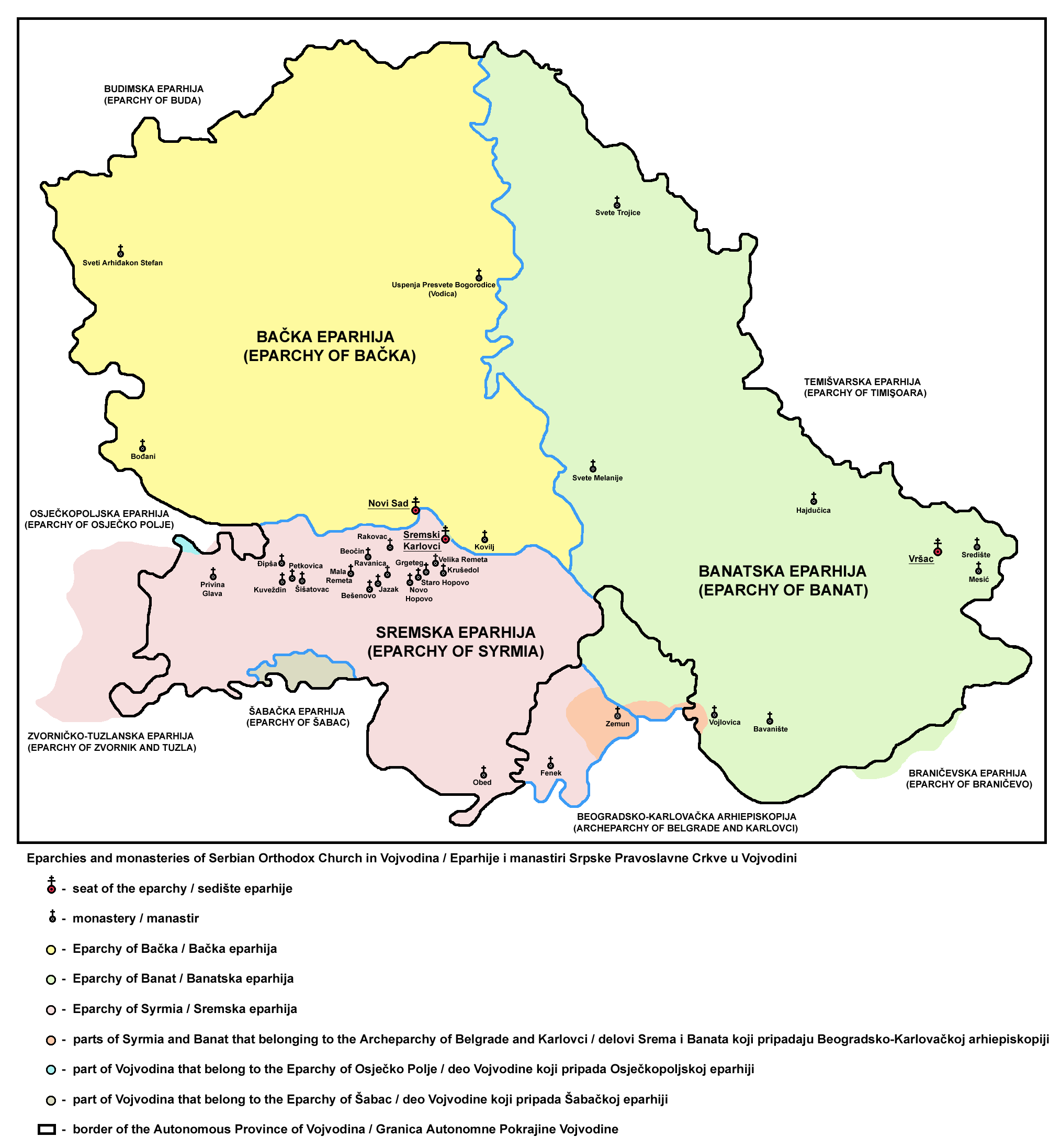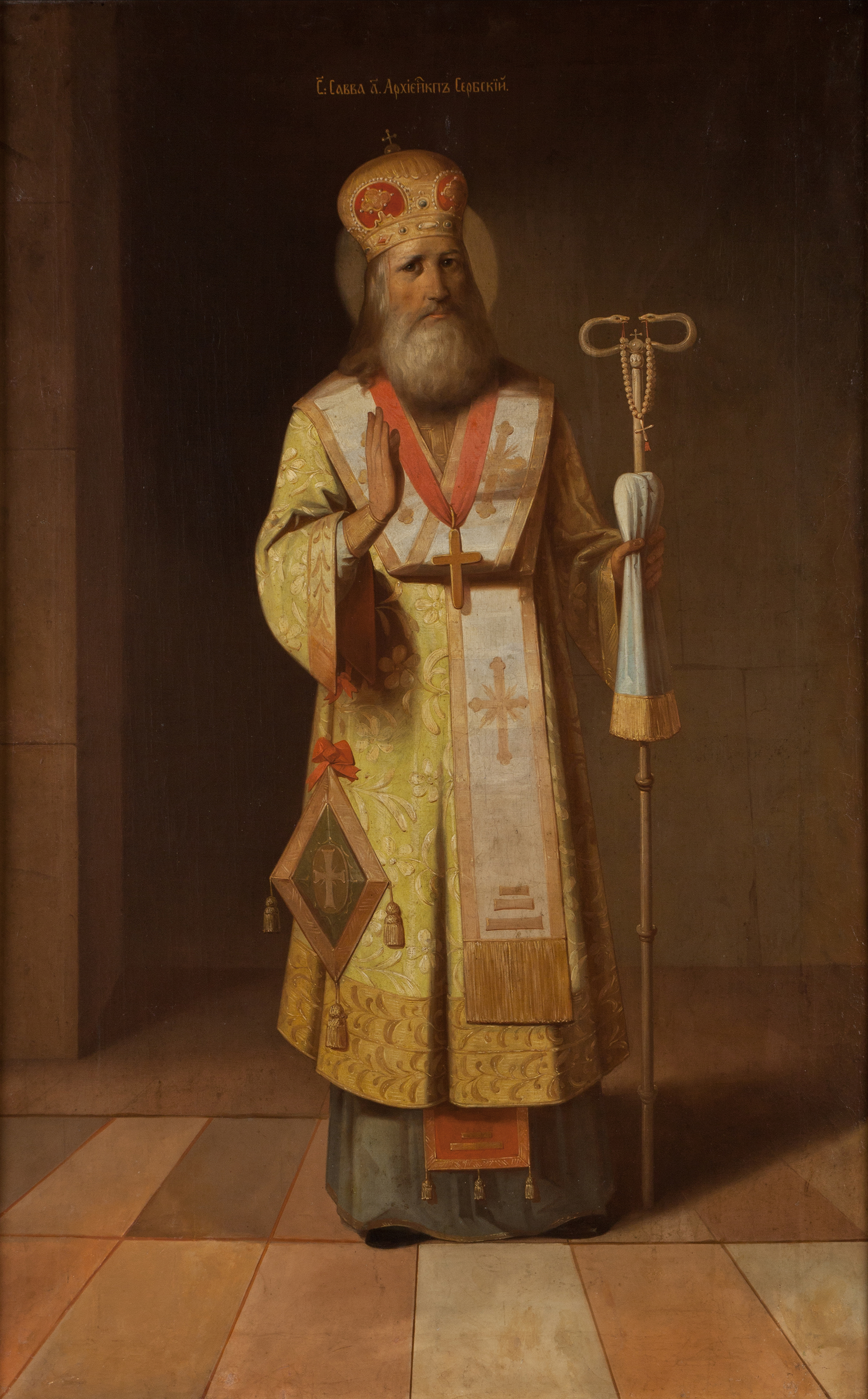|
Vrdnik-Ravanica Monastery
The Vrdnik-Ravanica Monastery ( sr, –ú–∞–Ω–∞—Å—Ç–∏—Ä –í—Ä–¥–Ω–∏–∫-–Ý–∞–≤–∞–Ω–∏—Ü–∞, Manastir Vrdnik-Ravanica), also known as Little Ravanica (–ú–∞–ª–∞ –Ý–∞–≤–∞–Ω–∏—Ü–∞'' / Mala Ravanica''), is a Serbian Orthodox monastery in Vrdnik in the Fru≈°ka Gora mountains in the northern Serbia, in the province of Vojvodina. The exact date of its founding is unknown. The records indicate that the church was built at the time of Metropolitan Serafim Jovanoviƒá, in the second half of the 16th century. The present church in the monastery was constructed in the period from 1801 to 1811. The icons on the altar screen and the vaults were painted by Dimitrije Avramoviƒá in 1853. Vrdnik-Ravanica Monastery was declared Monuments of Culture of Exceptional Importance (Serbia), Monument of Culture of Exceptional Importance in 1990, and it is protected by Republic of Serbia. See alsoMonasteries of Fru≈°ka Gora- Fru≈°kaƒá *Monuments of Culture of Exceptional Importance (Serbia), Monument of Culture of Exc ... [...More Info...] [...Related Items...] OR: [Wikipedia] [Google] [Baidu] |
Serbian Orthodox
The Serbian Orthodox Church ( sr-Cyrl, Српска православна црква, Srpska pravoslavna crkva) is one of the autocephalous (ecclesiastically independent) Eastern Orthodox Christian churches. The majority of the population in Serbia, Montenegro and the Republika Srpska entity of Bosnia and Herzegovina are members of the Serbian Orthodox Church. It is organized into metropolitanates and eparchies, located primarily in Serbia, Bosnia and Herzegovina, Montenegro, and Croatia. Other congregations are located in the Serb diaspora. The Serbian Patriarch serves as first among equals in his church. The current patriarch is Porfirije, enthroned on 19 February 2021. The Church achieved autocephalous status in 1219, under the leadership of Saint Sava, becoming the independent Archbishopric of Žiča. Its status was elevated to that of a patriarchate in 1346, and was known afterwards as the Serbian Patriarchate of Peć. This patriarchate was abolished by the Ottoman Em ... [...More Info...] [...Related Items...] OR: [Wikipedia] [Google] [Baidu] |
Monastery
A monastery is a building or complex of buildings comprising the domestic quarters and workplaces of monastics, monks or nuns, whether living in communities or alone (hermits). A monastery generally includes a place reserved for prayer which may be a chapel, church, or temple, and may also serve as an oratory, or in the case of communities anything from a single building housing only one senior and two or three junior monks or nuns, to vast complexes and estates housing tens or hundreds. A monastery complex typically comprises a number of buildings which include a church, dormitory, cloister, refectory, library, balneary and infirmary, and outlying granges. Depending on the location, the monastic order and the occupation of its inhabitants, the complex may also include a wide range of buildings that facilitate self-sufficiency and service to the community. These may include a hospice, a school, and a range of agricultural and manufacturing buildings such as a barn, a fo ... [...More Info...] [...Related Items...] OR: [Wikipedia] [Google] [Baidu] |
Vrdnik
Vrdnik ( sr-Cyrl, Врдник; ) is a village located in the municipality of Irig, northern Serbia, in the Vojvodina province of Serbia. It is located at southern slopes of Fruška Gora, at the border of the national park. As of 2011 census, it has a population of 3,092 inhabitants. Name In Serbian the village is known as ''Vrdnik'' (Врдник)and in Hungarian as ''Rednek''. Features Although small, the village has several distinctive features: a thermal spa, Vrdnik-Ravanica monastery from the 16th century, former coal mine with steam power plant built in 1911, but destroyed during NATO bombing of Yugoslavia in 1999, and a ruined castle, known as Castellum Rednek or '' Vrdnička kula'' (Tower of Vrdnik). Geography Vrdnik is placed near the heart of Fruška Gora, in a valley surrounded by its slopes, at elevation of 181–260 m and coordinates . The valley is formed by three creeks named ''Dubočaš'', ''Morintov potok'' and ''Veliki potok''. Most houses are built ... [...More Info...] [...Related Items...] OR: [Wikipedia] [Google] [Baidu] |
Fruška Gora
Fruška gora ( sr-Cyrl, Фрушка гора; hu, Tarcal-hegység) is a mountain in Syrmia, administratively part of Serbia with a part of its western side extending into eastern Croatia. The area under Serbian administration forms the country's oldest national park. Sometimes also referred to as the ''Jewel of Serbia'', due to its largely pristine landscape and protection effort, or the ''Serbian Mount Athos'', being the home of a large number of historical Serbian Orthodox monasteries. Name In Serbian, it is known as ''Fruška gora'' (, Фрушка гора), in Hungarian as ''Tarcal'' (also ''Almus-hegy'' or ''Árpatarló''), in German as ''Frankenwald'', and in Latin as ''Alma Mons''. In Medieval Greek, it was known as ''Frangochoria''. The mountain's name originates in the old Serbian word ''"Fruzi"'' derived from the singular form ''"Frug"''; and its adjective is ''Fruški'', used for naming the Frankish people. The name of ''"Fruška Gora"'' is ''"Frankish mountai ... [...More Info...] [...Related Items...] OR: [Wikipedia] [Google] [Baidu] |
Serbia
Serbia (, ; Serbian language, Serbian: , , ), officially the Republic of Serbia (Serbian language, Serbian: , , ), is a landlocked country in Southeast Europe, Southeastern and Central Europe, situated at the crossroads of the Pannonian Basin and the Balkans. It shares land borders with Hungary to the north, Romania to the northeast, Bulgaria to the southeast, North Macedonia to the south, Croatia and Bosnia and Herzegovina to the west, and Montenegro to the southwest, and claims a border with Albania through the Political status of Kosovo, disputed territory of Kosovo. Serbia without Kosovo has about 6.7 million inhabitants, about 8.4 million if Kosvo is included. Its capital Belgrade is also the List of cities in Serbia, largest city. Continuously inhabited since the Paleolithic Age, the territory of modern-day Serbia faced Slavs#Migrations, Slavic migrations in the 6th century, establishing several regional Principality of Serbia (early medieval), states in the early Mid ... [...More Info...] [...Related Items...] OR: [Wikipedia] [Google] [Baidu] |
Vojvodina
Vojvodina ( sr-Cyrl, Војводина}), officially the Autonomous Province of Vojvodina, is an autonomous province that occupies the northernmost part of Serbia. It lies within the Pannonian Basin, bordered to the south by the national capital Belgrade and the Sava and Danube Rivers. The administrative center, Novi Sad, is the second-largest city in Serbia. The historic regions of Banat, Bačka, and Syrmia overlap the province. Modern Vojvodina is multi-ethnic and multi-cultural, with some 26 ethnic groups and six official languages. About two million people, nearly 27% of Serbia's population, live in the province. Naming ''Vojvodina'' is also the Serbian word for voivodeship, a type of duchy overseen by a voivode. The Serbian Voivodeship, a precursor to modern Vojvodina, was an Austrian province from 1849 to 1860. Its official name is the Autonomous Province of Vojvodina. Its name in the province's six official languages is: * Croatian: ''Autonomna Pokrajina Vojvodina'' * ... [...More Info...] [...Related Items...] OR: [Wikipedia] [Google] [Baidu] |
Serafim Jovanović
Serafim may refer to: * '' Serafim, the Lighthouse Keeper's Son'', a Croatian film * Serafim (given name), a masculine given name See also * Serafin (other) * Seraphim (other) {{disambig ... [...More Info...] [...Related Items...] OR: [Wikipedia] [Google] [Baidu] |
Dimitrije Avramović
Dimitrije "Mita" Avramoviƒá (Serbian Cyrillic: –î–∏–º–∏—Ç—Ä–∏—ò–µ –ú–∏—Ç–∞ –ú–∏—Ç—Ä–∏–Ω–æ–≤–∏—õ; 15 March 1815 – 1 March 1855) was a Serbian writer, iconographer, caricaturist and painter in the Neoclassical style, considered to be the preeminent painter of the era and best known for his iconostasis and frescos. Avramoviƒá also translated from German into Serbian Johann Joachim Winckelmann's ''Geschichte der Kunst des Alterthums'' ("The History of Art in Antiquity") and other writings. He is considered the father of modern comic strips in Serbia. His caricatures were used to fight against the authoritarian rule of the masses in both the Austrian Empire and the Ottoman Empire at the time. Biography He was born in ≈Ýajka≈°, where he, as a boy, moved with his family to Novi Sad where he started schooling. In 1833 he went to Vienna for the first time, then again in 1835. He studied painting in Vienna privately with Friedrich Amerling, and then in 1836 to 1839 he was enrolled a ... [...More Info...] [...Related Items...] OR: [Wikipedia] [Google] [Baidu] |
Monuments Of Culture Of Exceptional Importance (Serbia)
Immovable Cultural Heritage of Exceptional Importance ( sr, –ù–µ–ø–æ–∫—Ä–µ—Ç–Ω–∞ –∫—É–ª—Ç—É—Ä–Ω–∞ –¥–æ–±—Ä–∞ –æ–¥ –∏–∑—É–∑–µ—Ç–Ω–æ–≥ –∑–Ω–∞—á–∞—ò–∞/) are those objects of Immovable cultural heritage that enjoy the highest level of state protection in the Republic of Serbia. Immovable Cultural Heritage is classified as being of Exceptional Importance upon decision by the National Assembly of Serbia. They are inscribed in the ''Central Register of Immovable cultural property'' maintained by the Institute for the Protection of Cultural Monuments of Serbia. Objects of Immovable cultural heritage have to fulfill one or more of those criteria defined in the ''Law on Cultural Heritage'' of 1994 in order to be categorized as being "of exceptional importance": # exceptional importance for social, historical or cultural development of the people, or for the development of its natural environment; # evidence of important historic events or persons and their work; # unique (rare) example of huma ... [...More Info...] [...Related Items...] OR: [Wikipedia] [Google] [Baidu] |
Republic Of Serbia
Serbia (, ; Serbian: , , ), officially the Republic of Serbia ( Serbian: , , ), is a landlocked country in Southeastern and Central Europe, situated at the crossroads of the Pannonian Basin and the Balkans. It shares land borders with Hungary to the north, Romania to the northeast, Bulgaria to the southeast, North Macedonia to the south, Croatia and Bosnia and Herzegovina to the west, and Montenegro to the southwest, and claims a border with Albania through the disputed territory of Kosovo. Serbia without Kosovo has about 6.7 million inhabitants, about 8.4 million if Kosvo is included. Its capital Belgrade is also the largest city. Continuously inhabited since the Paleolithic Age, the territory of modern-day Serbia faced Slavic migrations in the 6th century, establishing several regional states in the early Middle Ages at times recognised as tributaries to the Byzantine, Frankish and Hungarian kingdoms. The Serbian Kingdom obtained recognition by the Holy See and Const ... [...More Info...] [...Related Items...] OR: [Wikipedia] [Google] [Baidu] |
Tourism In Serbia
Tourism in Serbia is officially recognized as a primary area for economic and social growth. The hotel and catering sector accounted for approximately 2.2% of GDP in 2015. Tourism in Serbia employs some 75,000 people, about 3% of the country's workforce. In recent years the number of tourists is increasing, especially foreign ones for about hundred thousand arrivals more each year. In 2019, tourism generated an income of nearly $1.698 billion, hosting 3 million and seven hundred thousand tourists, half of whom were foreigners. Chinese tourists were the most numerous foreign visitors, followed by tourists from Bosnia and Herzegovina, Bulgaria, Turkey, and Germany. Major destinations for foreign tourists are Belgrade, Novi Sad and Niš, while domestic tourists prefer spas and mountain resorts. Eco-friendly and sustainable tourism has also become very popular among domestic tourists, with many young people visiting various nature reserves and parks in the western and southern part of ... [...More Info...] [...Related Items...] OR: [Wikipedia] [Google] [Baidu] |







